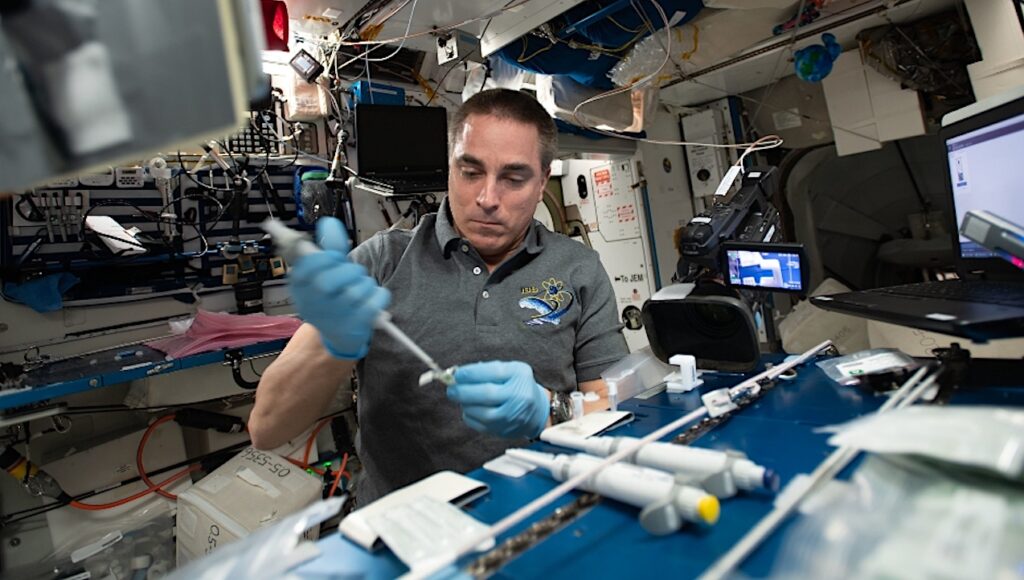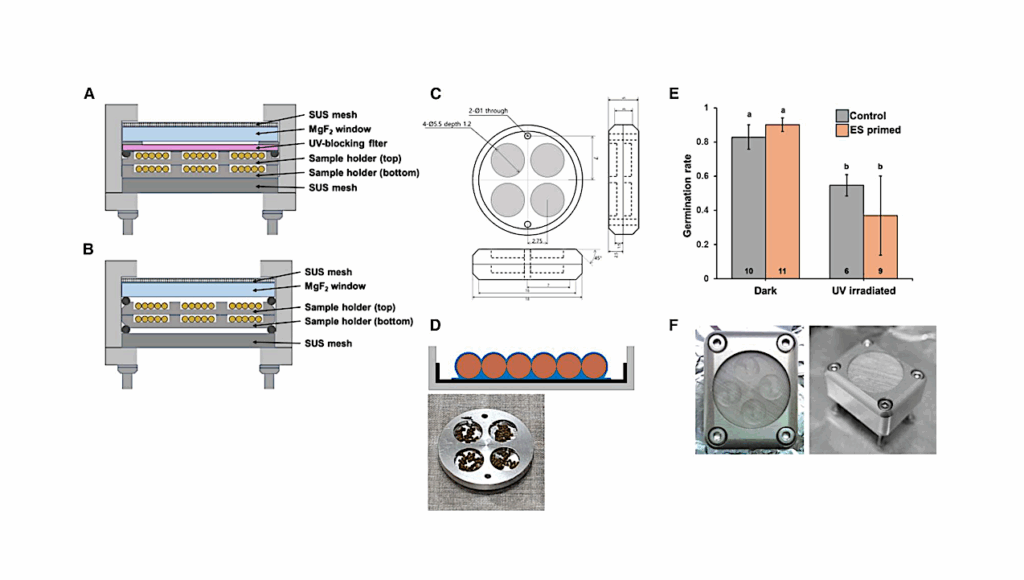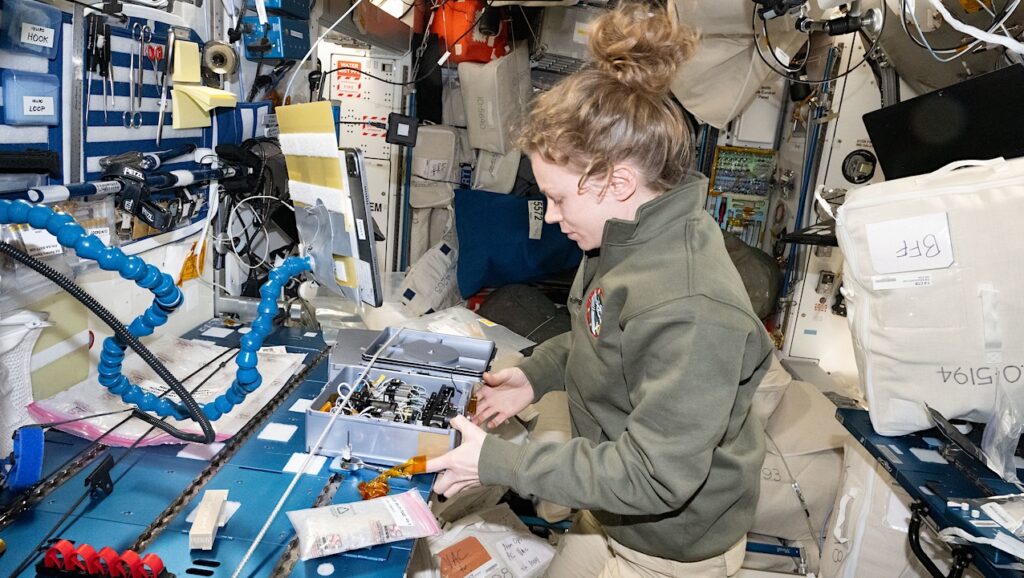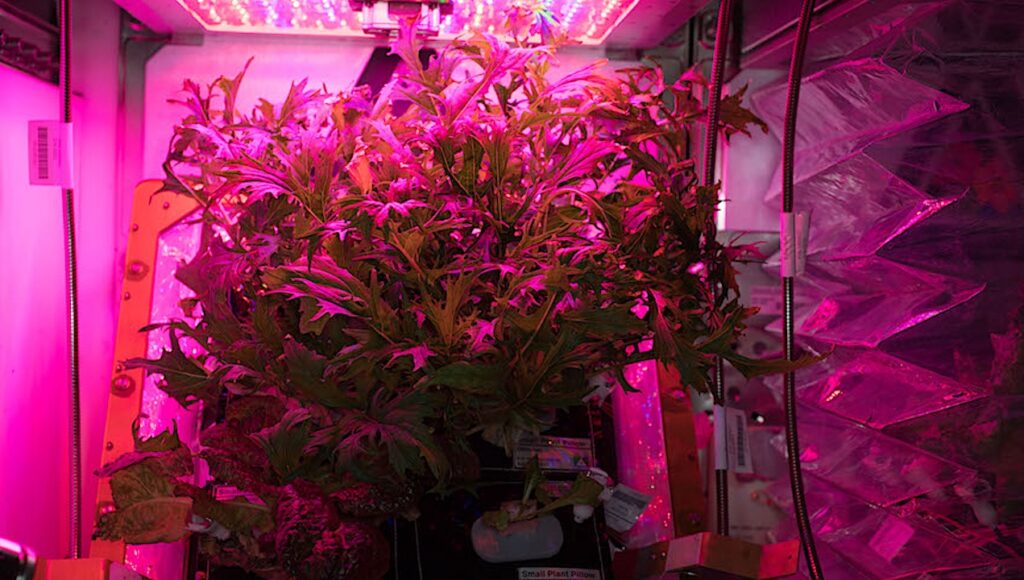NASA Spaceline Current Awareness List #1,114 30 August 2024 (Space Life Science Research Results)

The abstract in PubMed or at the publisher’s site is linked when available and will open in a new window.
Papers deriving from NASA support:
- Rosenthal R, Schneider VS, Jones JA, Sibonga JD.The case for bisphosphonate use in astronauts flying long-duration missions.Cells. 2024 Aug 13;13(16):1337. Review.Note: From the abstract: “This review aims to (i) highlight cellular analogies between spaceflight-induced and age-related bone loss, which could aid in predicting fractures, (ii) discuss why overreliance on terrestrial clinical approaches may miss potentially irreversible disruptions in trabecular bone microarchitecture induced by spaceflight, and (iii) detail how the cellular effects of the bisphosphonate class of drugs offer a prophylactic countermeasure for suppressing the elevated bone resorption characteristically observed during long-duration spaceflights. Thus the use of the bisphosphonate will help protect the bone from structural changes while in microgravity either along with exercise or alone when exercise is not performed, e.g. after an injury or illness.” This article may be obtained online without charge.
Journal Impact Factor: 5.1
Funding: “This research received no external funding. The Article Processing Charge associated with this publication was funded by the Human Health Countermeasures Element of NASA’s Human Research Program.” - Bauer L, Weinberger C, Carter DR, Blackwell Landon L.Managing spaceflight team stress: Considerations for multiteam system research.In: Harms PD, Chang C-H, eds. Stress and Well-Being in Teams. Research in Occupational Stress and Well-Being. Vol. 22. Leeds, England: Emeral Publishing, 2024. p. 171-86.PI: D.R. CarterFunding: “LB, CW, and DRC contributions were supported by NASA award #80NSSC23K1124. LBL was supported by KBR’s Human Health and Performance Contract #NNJ15HK11B through NASA.”
- Ghani F, Zubair AC.Discoveries from human stem cell research in space that are relevant to advancing cellular therapies on Earth.npj Microgravity. 2024 Aug 21;10(1):88. Review.PI: A.C. ZubairNote: This article may be obtained online without charge.
Journal Impact Factor: 5.1
Funding: PI reports NASA funding. - Li N, Phuyal S, Smits E, Reid FE, Tamgue EN, Arriaga PA, Britten RA.Exposure to low (10 cGy) doses of 4He ions leads to an apparent increase in risk taking propensity in female rats.Behav Brain Res. 2024 Oct 2;474:115182.PI: R.A. BrittenJournal Impact Factor: 2.6
Funding: “This work was supported by the NASA grant NNX14AE73G.” - Temple DR, Pepper S, Hogoboom BC, Klausing LN, Datta A, Burkhart C, Clark TK.Exploring GVS as a display modality: Signal amplitude and polarity, in various environments, impacts on posture, and with dual-tasking.Exp Brain Res. 2024 Aug 20.Note: From the abstract: “Galvanic Vestibular Stimulation (GVS) has been proposed as an alternative display modality to relay information without increasing demands on the visual or auditory sensory modalities of the wearer or in environments where those modalities cannot be used (e.g., covert night operations). We further investigated this concept with four experiments designed to test: (1) thresholds at which subjects could distinguish between different GVS current amplitudes and polarities, (2) thresholds at which different bipolar (i.e., sinusoidal waveform with current oscillating between left and right directions) current frequencies were distinguishable among room temperature, hot, cold, and windy environments, (3) effects of unipolar (i.e., sinusoidal waveform with current occurring in only the left or right direction) currents on balance performance, and (4) dual-task performance among frequency and polarity modulated GVS conditions during a concordant visual search task.”
Journal Impact Factor: 1.7
Funding: C. Burkhart is affiliated with NASA Johnson Space Center. - Sigdel S, Udoh G, Albalawy R, Wang J.Perivascular adipose tissue and perivascular adipose tissue-derived extracellular vesicles: New insights in vascular disease.Cells. 2024 Aug 6;13(16):1309. Review.Note: This article is part of Special Issue “Fat Is a Matter? The Implication of Adipose Tissue in Cardiovascular Health and Disease” (https://www.mdpi.com/journal/cells/special_issues/cells_adipose) and may be obtained online without charge.
Journal Impact Factor: 5.1
Funding: “This work was partially supported by the pilot grant (J.W.) of the National Institute of General Medical Sciences (U54GM104942), the NASA West Virginia Space Grant Consortium (80NSSC20M0055; S.S.), and the American Heart Association (AHA) Career Development Award (935826; J.W.) and Transformational Project Award (24TPA1291189; J.W.).” - Vo ATN, Murphy MA, Prabhu RK, Stone TW.Influence of phospholipid head and tail molecular structures on cell membrane mechanical response under tension.J Chem Phys. 2024 Aug 28;161(8):085103.Journal Impact Factor: 3.1
Funding: R.K. Prabhu is affiliated with NASA Johnson Space Center. - Huang M, Mark A, Pham J, Vera K, Saravia-Butler AM, Beheshti A, Jiang Q, Fisch KM.RNA editing regulates host immune response and T cell homeostasis in SARS-CoV-2 infection.PLoS One. 2024 Aug 23;19(8):e0307450.Note: This article may be obtained online without charge.
Journal Impact Factor: Not available for this journal
Funding: A.M. Saravia-Butler is affiliated with NASA Ames Research Center. - Varma C, Schroeder MK, Price BR, Khan KA, Curty da Costa E, Hochman-Mendez C, Caldarone BJ, Lemere CA.Long-term, sex-specific effects of GCRsim and gamma irradiation on the brains, hearts, and kidneys of mice with Alzheimer’s disease mutations.Int J Mol Sci. 2024 Aug 16;25(16):8948.PI: C.A. LemereNote: This article is part of Special Issue “Advanced Science in Alzheimer’s Disease” (https://www.mdpi.com/journal/ijms/special_issues/T2NC66U6RP). Additional articles will be forthcoming and may be found in the link to the Special Issue. This article may be obtained online without charge.
Journal Impact Factor: 4.9
Funding: “This research was funded by the National Aeronautics and Space Administration: 80NSSC18K0810.”
Other papers of interest:
Breen ID, Stepanek J, Marks L, Yale K, Mesinkovska N, Swanson D.Clinical significance of mottling rashes in diving decompression sickness.Aerosp Med Hum Perform. 2024 Sep;95(9):695-702.Note: From the abstract: “Decompression sickness (DCS) is a medical condition caused by outgassing of dissolved nitrogen following rapid ascent by divers and aviators. Cutaneous DCS, historically termed cutis marmorata (CM), presents as a predominantly truncal reticular violaceous-to-dusky eruption. The prevailing theories for its pathogenesis include: localized cutaneous outgassing, paradoxical embolism across a right-to-left shunt (RLS), and brainstem emboli disrupting autonomic control of cutaneous microcirculation.”
Khan FI, Somawardana I, Dongre R, Khan NS, Rashidi K, Razmi S, Hilmers D, Ahmed OG, Takashima M.Clearing new frontiers: Sinonasal health and the future of spaceflight.Ear Nose Throat J. 2024 Aug 26;1455613241274865. Online ahead of print.Note: From the article: “The coming decade will demonstrate the greatest expansion of human spaceflight since the Apollo era. The NASA’s Artemis Program and the massive expansion of the private aerospace industry indicate a need to fully comprehend health challenges faced by astronauts. However, while current missions involve healthy, professional astronauts, future missions will likely include tourists and private crewmembers who may have preexisting conditions that predispose them to otolaryngologic complications. Thus, there remains a need to explore the relationship between the field of otolaryngologic health and space travel. This perspective article will explore the potential rhinological and sinus health risks these individuals might face during spaceflight.” This article may be obtained online without charge.
Kudiabor H.“I hope I get the opportunity to fly”: Meet paralympian-turned-astronaut John McFall.Nature. 2024 Aug 22.Note: From the article: “Nature speaks to the world’s first disabled astronaut about his hopes for the future of space exploration.”
Lee R, Ong J, Waisberg E, Lee AG.Spaceflight associated dry eye syndrome (SADES): Radiation, stressors, and ocular surface health.Life Sci Space Res. 2024 Aug 30.
Rivera MV, Vargas M, Cornejo J, Velasco Plascencia P, Guillen K, Maquera E, Cornejo J, Russomano T, Cinelli I.Space nursing for the future management of astronaut health in other planets: A literature review.The Open Nursing Journal. 2024. Review.Note: This article may be obtained online without charge.
Ye R, He Y, Ni W, Zhang Y, Zhu Y, Cao M, He R, Yao M.LLLT [low-level light therapy] accelerates experimental wound healing under microgravity conditions via PI3K/AKT-CCR2 signal axis.Front Bioeng Biotechnol. 2024 Aug 12;12:1387474.Note: Hindlimb unloading study. This article may be obtained online without charge.
Krakos A.When Earth is not enough: Lab-on-a-chip accelerating space research.In: Parihar A, Pradeep Mehta P, eds. Lab-on-a-chip Devices for Advanced Biomedicines: Laboratory Scale Engineering to Clinical Ecosystem. London: Royal Society of Chemistry, 2024. p. 402-29.Note: From the introduction: “The popularity of lab-on-a-chip (LOC) instruments for space research has grown notably in recent times. The subject of space biology has become an especially interesting area in which the application of LOCs is expected to bring measurable benefits. The opportunity to investigate the behavior of biological samples in microgravity and radiation conditions, utilizing reliable LOC instrumentation, provides new knowledge on specific and hitherto unknown cellular mechanisms. This, in turn, opens the way towards the development of novel biomedical methodologies and therapeutic strategies. This chapter reports on recent space-related research that has been conducted utilizing microfluidic technologies.”
Sowmeya VG, Sathiavelu M.Biofilm dynamics in space and their potential for sustainable space exploration — A comprehensive review.Life Sci Space Res. 2024 Aug 24. Review. Online ahead of printNote: From the abstract: “Microbial biofilms are universal. The intricate tapestry of biofilms has remarkable implications for the environment, health, and industrial processes. The field of space microbiology is actively investigating the effects of microgravity on microbes, and discoveries are constantly being made. Recent evidence suggests that extraterrestrial environments also fuel the biofilm formation. Understanding the biofilm mechanics under microgravitational conditions is crucial at this stage and could have an astounding impact on inter-planetary missions. This review systematically examines the existing understanding of biofilm development in space and provides insight into how molecules, physiology, or environmental factors influence biofilm formation during microgravitational conditions.”
Cherry J, Ayton J, Cooper D, Graeme Z.A systematic review of medical emergencies in Antarctica: Lessons for long-duration spaceflight.Acta Astronaut. 2024 Aug 27. Online ahead of print.
Russomano T, Vinagre NAC, Gessinger RP, de C Castro J, da S Herbert J, Oliveira A, Oliveira E, Costa KLG, Xavier AP, Ruiz R.Brief review: Virtual reality and physical exercise as countermeasures of coping the space missionsHealth Nexus. 2024;2(2):30-40.Note: This is a perspective article and may be obtained online without charge.
Ai W, Deng Y, Wu C, Yang J, Tang Y, Zhang L, Yu Q, Li Y.Solid waste management and resource recovery during the 4-crew 180-day CELSS integrated experiment.Life Sci Space Res. 2024 Aug 23. Online ahead of print.
Wu Q, Wu J, Huang L, Yang Z, Shang L, Wang H, Yin J.In situ study on articular cartilage degeneration in simulated microgravity by HOF-ATR-FTIR spectroscopy.Spectrochim Acta A Mol Biomol Spectrosc. 2025 Jan;324:125000.Note: This article is a short communication.
Zhao L, Cui J, Fu Y, Liu H.Specific rhizobacterial assembly enhances the physiological adaptation of soil-cultivated wheat to simulated microgravity.Acta Astronaut. 2024 Oct; 223:723-33.Note: From the abstract: “Plants have evolved various strategies for assembling rhizosphere microbiota in response to abiotic stressors. However, our understanding of rhizosphere bacterial community assembly and function under microgravity conditions is limited, especially when soil serves as the growth substrate. Here, using microgravity analogs, we compared the bacterial communities in both the rhizosphere and bulk soil of wheat plants grown in soil under normal gravity and simulated microgravity conditions through 16S rRNA gene amplicon sequencing.”
Stark CM, Sorensen IS, Royall M, Dorr M, Brown J, Dobson N, Salzman S, Susi A, Hisle-Gorman E, Huggins BH, Nylund CM.Maternal and fetal health risks among female military aviation officers.Aerosp Med Hum Perform. 2024 Sep;95(9):675-82.
Mansouri F, Nia MT, Villar R, Cornish SM, Giesbrecht GG.Upper- vs. whole-body cooling during exercise with thermal protective clothing in the heat.Aerosp Med Hum Perform. 2024 Sep;95(9):659-66.Note: From the abstract: “The study aim was to compare effectiveness of the same amount of cooling power to the upper body (UB) or whole body (WB) in alleviating thermoregulatory and physiological stress, enhancing cognitive function, and reducing ratings of thermal discomfort and exertion, during 60 minutes of exercise in a hot environment (40°C, 40% relative humidity) while wearing firefighter turnout gear.”
Connolly DM, Madden LA, Edwards VC, Lee VM.Brain and lung biomarker responses to hyperoxic hypobaric decompression.Aerosp Med Hum Perform. 2024 Sep;95(9):667-74.
Pontiggia A, Fabries P, Beauchamps V, Quiquempoix M, Nespoulous O, Jacques C, Guillard M, Van Beers P, Ayounts H, Koulmann N, Gomez-Merino D, Chennaoui M, Sauvet F.Combined effects of moderate hypoxia and sleep restriction on mental workload.Clocks Sleep. 2024 Jul 23;6(3):338-58.Note: This article is part of Section “Human Basic Research & Neuroimaging” (https://www.mdpi.com/journal/clockssleep/sections/CS_Human_Basic_Research) and may be obtained online without charge.
Thanapaisan P, Plaingam M, Manyanont S.Polycythemia prevalence and risk factors in pilots.Aerosp Med Hum Perform. 2024 Sep;95(9):683-7.Note: From the abstract: “Pilots are frequently exposed to thrombotic risk as a result of immobility from air travel. As hypoxemia is associated with secondary polycythemia, and polycythemia increases the risk of thrombosis, intermittent exposure to high-altitude hypoxic environments could escalate the risk of thrombosis in pilots. Our objectives were to find the prevalence of polycythemia in airplane pilots (primary outcome) and to assess associated risk factors of polycythemia (secondary outcome).”
Astrobiology, space life science, space medicine, space biology,








